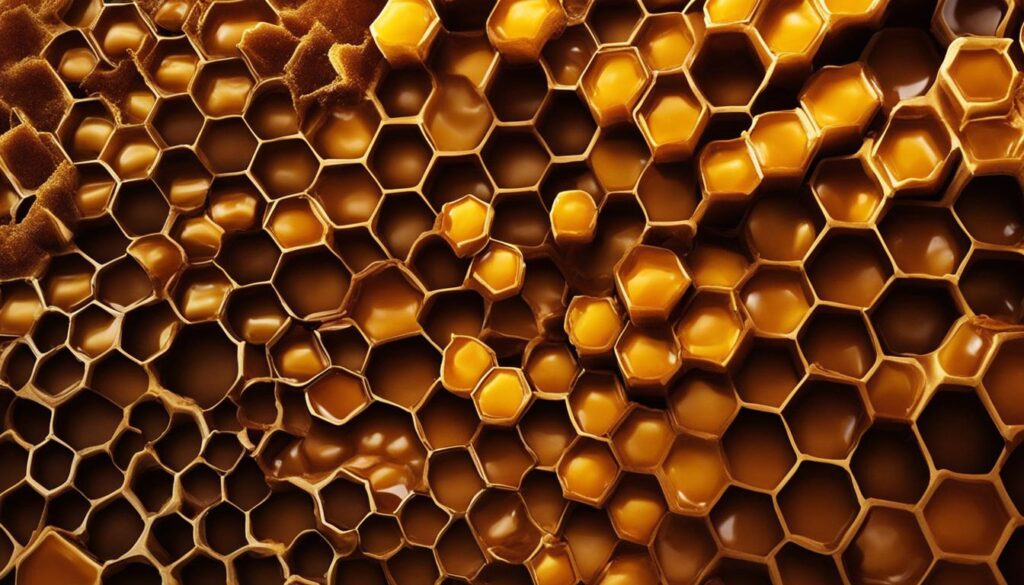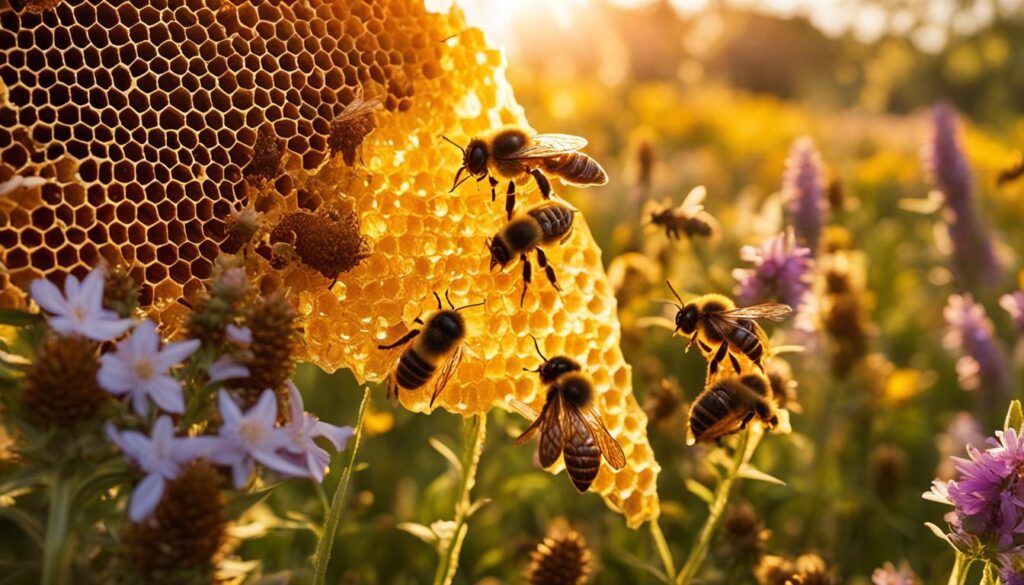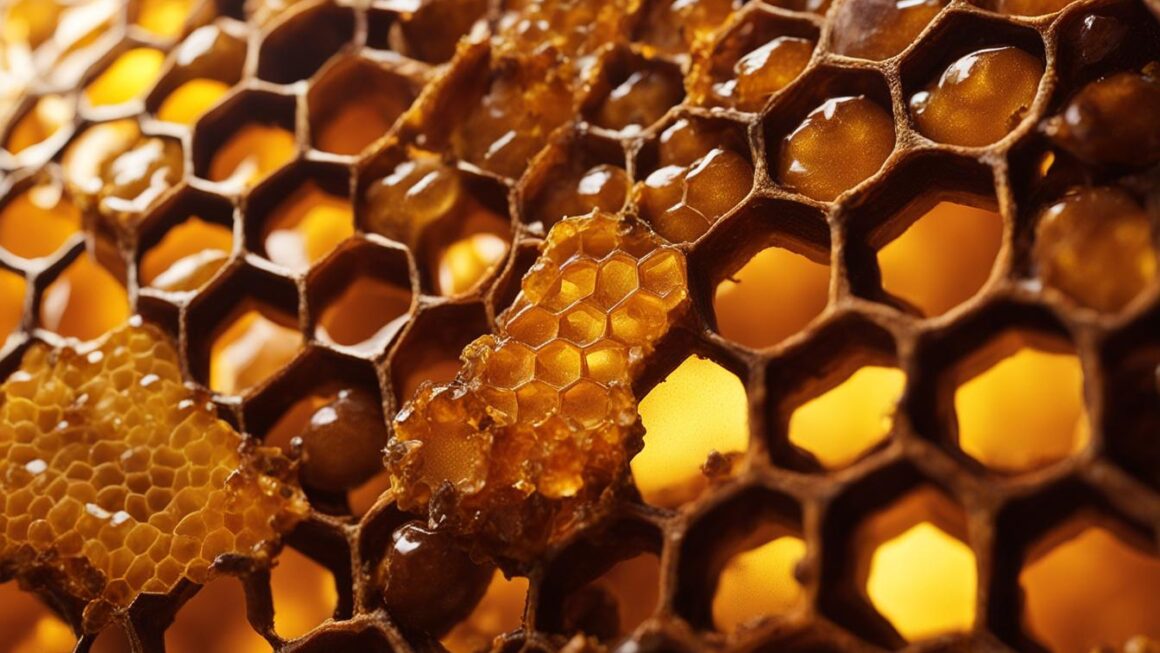Honeycomb has been admired since ancient times for its unique hexagonal structure and healing properties. From the Pantheon in Rome to references in Egyptian hieroglyphs and Greek mythology, honeycomb has fascinated people throughout history. It is not only edible but also considered a superfood, rich in carbohydrates, antioxidants, vitamins, minerals, and protein. Honeycomb is often viewed as a natural medicine with potential benefits such as reducing high blood cholesterol levels. The natural, waxy comb is 100% edible and can be enjoyed on its own or incorporated into various dishes.
Key Takeaways:
- Natural honeycomb has a unique hexagonal structure and is rich in nutrients.
- Honeycomb is considered a superfood due to its high antioxidant content.
- It has potential health benefits such as reducing high blood cholesterol levels.
- Honeycomb is 100% edible and can be enjoyed on its own or incorporated into various dishes.
- Explore the world of honeycomb and embark on a sweet journey of taste and wellbeing.
The History and Significance of Honeycomb
Honeycomb has a rich history and holds significance in various cultures and fields. It has been referenced in ancient texts like the Bible and the Quran and admired by great minds like Galileo, Robert Hooke, and Charles Darwin. The hexagonal structure has inspired architectural designs, aircraft technology, crash absorption materials, LED technology, and more. Beeswax candles, made from honeycomb, have lit historical records and documents. The fascination with honeycomb stems from its perfect structure and composition.
Honeycomb in Ancient Texts and References
“…and I have come down to deliver them out of the hand of the Egyptians and to bring them up out of that land to a good and broad land, a land flowing with milk and honey, to the place of the Canaanites…” – Exodus 3:8
Throughout history, honeycomb has been mentioned in ancient texts and revered for its symbolism and significance. In religious texts like the Bible and the Quran, honeycomb is often associated with abundance, prosperity, and the promised land. The mention of “a land flowing with milk and honey” evokes images of richness and fertility.
The Hexagonal Wonder: Inspiration for Science and Technology
The hexagonal structure of honeycomb has captivated scientists, engineers, and architects for centuries. The efficiency of this shape in maximizing space and strength has led to its application in various fields. From the beehive-inspired architecture of the Pantheon in Rome to the honeycomb core used in aircraft technology, the influence of honeycomb can be seen in iconic structures and innovations.
| Field | Inspired Application |
|---|---|
| Architecture | Pantheon’s dome |
| Engineering | Aircraft technology |
| Materials Science | Crash absorption materials |
| Lighting | LED technology |
From structural integrity to energy efficiency, the honeycomb structure continues to inspire innovation and advancements in various industries.
The Benefits of Eating Honeycomb
Honeycomb is considered a superfood due to its rich nutritional profile. It contains carbohydrates, antioxidants, vitamins, minerals, and protein derived from bee pollen, propolis, and royal jelly. Beeswax in honeycomb may help reduce high blood cholesterol levels. Eating honeycomb is believed to have various health benefits, although specific benefits may vary. Some suggest it can aid in digestion, boost the immune system, and provide energy. There are also claims that honeycomb can have antimicrobial and anti-inflammatory properties. Further research is needed to fully understand and validate these claims.
When it comes to honeycomb, it’s not just about the nutritional benefits. The unique texture and taste of honeycomb add to its appeal. With its chewy and waxy consistency, honeycomb provides a delightful experience for the senses. Whether enjoyed on its own or incorporated into recipes, honeycomb can elevate the flavor profile of various dishes.
The Nutritional Profile of Honeycomb
Honeycomb is packed with essential nutrients and bioactive compounds. Here is a breakdown of some key components:
| Nutrient | Benefits |
|---|---|
| Carbohydrates | Provides energy |
| Antioxidants | Helps protect against cell damage |
| Vitamins | Contributes to overall health and immune system function |
| Minerals | Supports various bodily functions, such as bone health and enzyme production |
| Protein | Builds and repairs body tissues |
It’s important to note that the nutritional composition of honeycomb can vary depending on factors such as the type of flowers bees gather nectar from and the region where the honeycomb is produced. Opting for high-quality, organic honeycomb can ensure you’re getting the best nutritional value.
“I love incorporating honeycomb into my diet. Its delicious taste and potential health benefits make it a win-win. Plus, it adds a unique touch to my favorite recipes!” – Sarah, honeycomb enthusiast
How to Eat Honeycomb
Honeycomb is a versatile and delicious treat that can be enjoyed in various ways. Whether you prefer to savor its natural chewiness or incorporate it into your favorite dishes, honeycomb adds a unique and sweet touch to any meal. Here are some ideas on how to use honeycomb:
- Eating it straight: One of the simplest and most enjoyable ways to eat honeycomb is to enjoy it on its own. Just take a piece of honeycomb from the hive and bite into its natural sweetness. The waxiness and chewiness of the comb create a delightful mouthfeel.
- Pairing it with cheese and crackers: Honeycomb can be a beautiful centerpiece for a cheese and cracker board. Its natural sweetness complements different types of cheese, enhancing their flavor. Simply place a chunk of honeycomb alongside your favorite cheeses and enjoy the combination of savory and sweet.
- Spreading it on bread or sandwiches: For a quick and delicious snack, spread honeycomb onto bread or use it as a unique addition to your favorite sandwiches. The sweetness of the honeycomb pairs well with savory ingredients like ham or cheese, creating a mouthwatering balance of flavors.
- Incorporating it into recipes: Honeycomb can be a delightful addition to a wide range of recipes. Add small chunks of honeycomb to warm cocoa or melt it into soups for a touch of natural sweetness. You can also blend it into smoothies or incorporate it into baking batters for a unique twist. The possibilities are endless!
With its versatility and natural sweetness, honeycomb is a delightful ingredient that can be enjoyed in many ways. Get creative and explore the endless possibilities of incorporating honeycomb into your favorite dishes!

| Method | Description |
|---|---|
| Straight from the hive | Eat honeycomb on its own, savoring its natural sweetness and chewiness. |
| Pairing with cheese and crackers | Place honeycomb on a cheese and cracker board to enhance the flavor of different types of cheese. |
| Spreading on bread or sandwiches | Enjoy honeycomb by spreading it on bread or adding it to your favorite sandwiches. |
| Incorporating into recipes | Add honeycomb to warm cocoa, soups, smoothies, baking batters, or as a topping for pancakes, waffles, or salads. |
Introducing Sadaf Honey Comb: A Delightful Treat
Sadaf Honey Comb offers a delightful and natural honeycomb treat that is sure to satisfy your taste buds. Made from 100% pure and raw honeycomb sourced from the finest honeybees in the US, Sadaf Honey Comb brings you the perfect combination of chewiness, waxiness, and nutritional value. With no artificial preservatives or additives, you can enjoy the pure, natural taste and experience maximum health benefits.
Our honeycomb is carefully packaged in a convenient and resealable container, making it easy to enjoy whenever you crave a sweet treat. Whether you prefer to savor it on its own or pair it with cheese, desserts, or breakfast spreads, Sadaf Honey Comb is a versatile and delicious addition to your pantry.
Experience the richness of natural honeycomb with Sadaf Honey Comb. Indulge in its unique texture and flavor and embark on a delightful journey of taste and wellbeing.

| Honeycomb Benefits | Nutritional Profile | Usage Ideas |
|---|---|---|
|
|
|
The Nostalgic Pleasure of Raw Honeycomb
Raw honeycomb holds a special place in many people’s memories, evoking feelings of nostalgia and warmth. In the past, family farms often had beehives, and fresh honeycomb was a special treat shared with loved ones. Biting into a piece of honeycomb brought joy and satisfaction. The tradition of enjoying raw honeycomb passed down through generations, with stories of grandparents crushing it onto buttered bread or peanut-buttered bread. It was a simple and wholesome pleasure that continues to create lasting memories.
For those who have experienced the delight of raw honeycomb, it is more than just a delicious treat. It represents a connection to nature, a sense of tradition, and a reminder of simpler times. The unique texture and flavor of raw honeycomb cannot be replicated by any other sweetener. Every bite carries the essence of the bees’ hard work and the natural sweetness of the nectar they collect.
“Biting into a piece of honeycomb brought joy and satisfaction. The tradition of enjoying raw honeycomb passed down through generations.”
Raw honeycomb can be enjoyed in various ways, allowing individuals to savor its nostalgic pleasure. Whether eaten on its own, spread on toast, or added to recipes, it adds a unique touch to any dish. Its natural sweetness and chewy texture create a delightful sensory experience that transports people back to simpler times. By embracing the tradition of raw honeycomb, individuals can reconnect with their roots and create new memories to pass down to future generations.
The Benefits of Raw Honeycomb:
- Rich in antioxidants and vitamins
- Packed with natural enzymes and minerals
- Possible antimicrobial and anti-inflammatory properties
- Potential digestive aid
- A source of natural energy
The Making and Composition of Honeycomb
Honeycomb is a remarkable creation of nature, crafted with precision and efficiency by our buzzing friends, the bees. Let’s delve into the fascinating process of how bees make honeycomb and explore the composition of this natural wonder.
The Making of Honeycomb
Bees create honeycomb by utilizing their wax glands. They secrete beeswax, which forms small scales that are meticulously shaped into the iconic hexagonal cells we recognize as honeycomb. These cells serve as storage units for honey, pollen, and other essential bee products.
As bees construct the honeycomb, they add the honey they produce, filling each cell with this delicious and nutritious substance. The beeswax starts off as white when freshly made but gradually turns yellow as bees walk over it, carrying pollen on their bodies. This transformation adds to the unique visual appeal of honeycomb.
The Composition of Honeycomb
Honeycomb is composed of various components that contribute to its nutritional value and health benefits. The primary ingredient is beeswax, which forms the structure of the comb. Beyond beeswax, honeycomb also contains honey, bee pollen, propolis, and royal jelly.
These additional elements bring a wealth of nutrients to honeycomb. Honey, of course, is a natural sweetener that provides carbohydrates and antioxidants. Bee pollen is rich in vitamins, minerals, and protein. Propolis, a resinous substance collected by bees, has antimicrobial properties, while royal jelly is a nutrient-rich secretion produced by worker bees to nourish the queen bee.
Together, these components create a harmonious blend within the honeycomb, offering a unique combination of taste and health benefits. It’s no wonder that honeycomb has been treasured for centuries as both a culinary delight and a natural remedy.
Pairing Honeycomb with Tea: A Flavorful Combination
Honeycomb and tea make a delightful pairing, creating a harmonious balance of sweetness and flavor. Whether you prefer a robust black tea, a calming herbal infusion, or a refreshing green tea, there is a honeycomb variety that can elevate your tea-drinking experience. The natural sweetness of honeycomb enhances the taste of tea, providing a natural and healthier alternative to processed sweeteners.
When selecting a honeycomb variety to pair with your tea, consider the flavor profile of both. For black teas, darker honeycombs such as wildflower honey bring depth and richness to the brew. The boldness of black tea is complemented by the complex flavors of wildflower honey. For those who enjoy herbal teas, fruity or floral honeycombs like tupelo or orange blossom honey add a fragrant sweetness that enhances the gentle and soothing qualities of herbal infusions.
Green tea, with its delicate and subtle flavors, pairs well with bolder honey varieties. Orange blossom or sage honey, with their distinctive and robust tastes, can complement the earthy notes of green tea. The combination of green tea and honeycomb creates a nuanced and satisfying drinking experience.
Indulging in the pairing of honeycomb and tea can be a soothing and enjoyable ritual. Take the time to savor each sip, allowing the flavors to mingle and unfold. Whether you are relaxing alone in the afternoon or sharing tea with friends, the combination of honeycomb and tea is sure to create a flavorful and memorable experience.
Table: Honeycomb Varieties and Tea Pairings
| Honeycomb Variety | Tea Pairing |
|---|---|
| Wildflower Honeycomb | Black Teas |
| Tupelo Honeycomb | Herbal Teas |
| Orange Blossom Honeycomb | Green Teas |
| Sage Honeycomb | Green Teas |
Conclusion
Natural honeycomb is not only a delicious treat but also a source of health benefits. Its rich nutritional profile, unique structure, and historical significance make it a valuable addition to any kitchen. Whether eaten on its own or incorporated into various dishes, honeycomb provides a sweet and wholesome experience.
Sadaf Honey Comb offers a premium-quality, natural honeycomb, allowing individuals to indulge in its richness and goodness. Their 100% pure honeycomb is sourced from the finest honeybees in the US, ensuring a pure, natural taste and maximum health benefits. Packaged in a convenient and resealable container, it is a perfect addition to any pantry.
Embark on a sweet journey of taste and wellbeing as you explore the world of honeycomb. Incorporate this delightful treat into your daily routine and elevate your culinary experience. From its nutritional value to its historical significance, honeycomb truly is a remarkable creation of nature that brings joy and satisfaction to all who enjoy it.
FAQ
What are the benefits of eating honeycomb?
Honeycomb is considered a superfood, rich in carbohydrates, antioxidants, vitamins, minerals, and protein. It may help reduce high blood cholesterol levels and has potential benefits for digestion, immune system health, and providing energy. However, specific benefits may vary, and further research is needed to fully understand and validate these claims.
How can honeycomb be enjoyed?
Honeycomb can be enjoyed in multiple ways. It can be eaten on its own, used as a centerpiece for cheese and cracker boards, smeared on bread or grilled cheese sandwiches, added to warm cocoa or soups, blended into smoothies or baking batters, and used as a topping for pancakes, waffles, or salads. Some restaurants even present honeycomb frames on tables, surrounded by farm fresh cheeses and other delights.
What is Sadaf Honey Comb?
Sadaf Honey Comb offers a 100% pure and natural honeycomb sourced from the finest honeybees in the US. It is free from artificial preservatives or additives, ensuring a pure, natural taste and maximum health benefits. Packaged in a convenient and resealable container, it is a perfect addition to any pantry.
How is honeycomb made?
Honeycomb is made by bees using their wax glands. They secrete beeswax, which is shaped into hexagonal cells. Bees then add honey to these cells, creating the unique structure. Honeycomb is composed of beeswax, honey, bee pollen, propolis, and royal jelly.
How does honeycomb enhance the taste of tea?
Honeycomb adds sweetness and depth of flavor to tea. It is a natural and healthier alternative to processed sweeteners. The choice of honeycomb should be based on the flavor profile of both tea and honey. Darker honeycombs, like wildflower honey, work well with black teas, while fruity or floral honeycombs, such as tupelo or orange blossom honey, complement herbal teas. Green tea pairs nicely with bolder honey varieties like orange blossom or sage honey.




